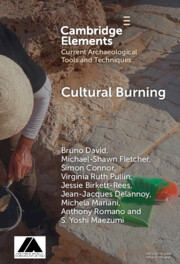559 results

Cultural Burning
- Coming soon
-
- Expected online publication date:
- June 2024
- Print publication:
- 30 June 2024
-
- Element
- Export citation
IUCN Red List Training and Assessment Workshop for Africa's bats, Namibia
-
- Article
-
- You have access
- Open access
- HTML
- Export citation
Update and synthesis of the available archaeological and geochronological data for the Lower Paleolithic site of Loreto at Venosa (Basilicata, Italy)
-
- Journal:
- Quaternary Research , First View
- Published online by Cambridge University Press:
- 23 February 2024, pp. 1-16
-
- Article
- Export citation
High touch surface bioburden associated with the use of disinfectants with and without continuously active disinfection in ambulatory care settings
-
- Journal:
- Infection Control & Hospital Epidemiology , First View
- Published online by Cambridge University Press:
- 20 February 2024, pp. 1-3
-
- Article
-
- You have access
- Open access
- HTML
- Export citation
P63: Best Practice Guidance on Human Interaction with Technology in Dementia Update June 2023 – Recommendations from the INDUCT and DISTINCT Networks
-
- Journal:
- International Psychogeriatrics / Volume 35 / Issue S1 / December 2023
- Published online by Cambridge University Press:
- 02 February 2024, pp. 158-159
-
- Article
-
- You have access
- Export citation
Learning needs of junior doctors in otolaryngology: a qualitative study
-
- Journal:
- The Journal of Laryngology & Otology , First View
- Published online by Cambridge University Press:
- 17 January 2024, pp. 1-9
-
- Article
- Export citation
Organic Geochemical Composition of the Georgia Kaolins: Insights into Formation and Diagenetic Conditions
-
- Journal:
- Clays and Clay Minerals / Volume 60 / Issue 4 / August 2012
- Published online by Cambridge University Press:
- 01 January 2024, pp. 420-439
-
- Article
- Export citation
OP122 Economic Evidence To Support Expanding Use Of Existing Positron Emission Tomography Technology As A Diagnostic Tool For High-Risk Cancer Patients
-
- Journal:
- International Journal of Technology Assessment in Health Care / Volume 39 / Issue S1 / December 2023
- Published online by Cambridge University Press:
- 14 December 2023, pp. S34-S35
-
- Article
-
- You have access
- Export citation
OP115 Scoping Meta-Review On Methods Used To Assess Artificial Intelligence-Based Medical Devices For Heart Failure
-
- Journal:
- International Journal of Technology Assessment in Health Care / Volume 39 / Issue S1 / December 2023
- Published online by Cambridge University Press:
- 14 December 2023, p. S32
-
- Article
-
- You have access
- Export citation
Prehospital Mass Casualty Incident Response to a Fire in a Nursing Home in Milan, Italy: Actions Taken and Shortcomings
-
- Journal:
- Disaster Medicine and Public Health Preparedness / Volume 17 / 2023
- Published online by Cambridge University Press:
- 14 December 2023, e563
-
- Article
- Export citation
The relationship between parent's self-reported exposure to food marketing and child and parental purchasing and consumption outcomes in five countries: findings from the International Food Policy Study
-
- Journal:
- Journal of Nutritional Science / Volume 12 / 2023
- Published online by Cambridge University Press:
- 07 December 2023, e123
-
- Article
-
- You have access
- Open access
- HTML
- Export citation
Changes in audiovestibular handicap following treatment of vestibular schwannomas
-
- Journal:
- The Journal of Laryngology & Otology , First View
- Published online by Cambridge University Press:
- 29 November 2023, pp. 1-7
-
- Article
-
- You have access
- Open access
- HTML
- Export citation
GWAS of Dizygotic Twinning in an Enlarged Australian Sample of Mothers of DZ Twins
-
- Journal:
- Twin Research and Human Genetics / Volume 26 / Issue 6 / December 2023
- Published online by Cambridge University Press:
- 23 November 2023, pp. 327-338
-
- Article
-
- You have access
- Open access
- HTML
- Export citation
Radiofrequency ice dielectric measurements at Summit Station, Greenland
-
- Journal:
- Journal of Glaciology , First View
- Published online by Cambridge University Press:
- 09 October 2023, pp. 1-12
-
- Article
-
- You have access
- Open access
- HTML
- Export citation
Effects of front-of-package caffeine and sweetener disclaimers in Mexico: cross-sectional results from the 2020 International Food Policy Study
-
- Journal:
- Public Health Nutrition / Volume 26 / Issue 12 / December 2023
- Published online by Cambridge University Press:
- 02 October 2023, pp. 3278-3290
-
- Article
-
- You have access
- Open access
- HTML
- Export citation
Contents
-
- Book:
- Bedfordshire Churches in the Nineteenth Century
- Published by:
- Boydell & Brewer
- Published online:
- 05 August 2023, pp iii-iii
-
- Chapter
- Export citation
Introduction to the series
-
- Book:
- Bedfordshire Churches in the Nineteenth Century
- Published by:
- Boydell & Brewer
- Published online:
- 05 August 2023, pp viii-x
-
- Chapter
- Export citation
Frontmatter
-
- Book:
- Bedfordshire Churches in the Nineteenth Century
- Published by:
- Boydell & Brewer
- Published online:
- 05 August 2023, pp i-ii
-
- Chapter
- Export citation
Notes on sources: The sources - introduction
-
- Book:
- Bedfordshire Churches in the Nineteenth Century
- Published by:
- Boydell & Brewer
- Published online:
- 05 August 2023, pp 2-25
-
- Chapter
- Export citation
Symbols Used In Transcription
-
- Book:
- Bedfordshire Churches in the Nineteenth Century
- Published by:
- Boydell & Brewer
- Published online:
- 05 August 2023, pp xiii-xiii
-
- Chapter
- Export citation




